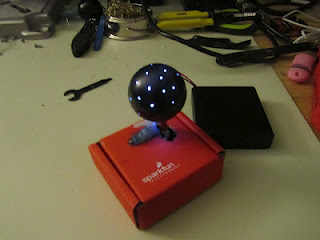
[Zach] saw a stuffed animal that projected some simple stars on the ceiling. This gave him an idea that he could build a tiny star projector for his 3 month old daughter’s room. The idea is to put an LED inside a ping pong ball with tiny holes and rotate it slowly.
The electronics are fairly strait forward. He’s using an MSP430 to control the servo and LED, allowing him to set different speeds and turn the whole thing off after a certain amount of time. The ball took a little bit of trial and error though. He first started by drilling some holes, but found this to give poor results. The holes were just too big. He finally ended up heating up a sewing needle and melting tiny holes in the ping pong ball. That worked perfect.
After the break you can see a video of it moving. The servo is pretty loud, which might actually be a good distraction for a 3month old, but might be something to address in the future.











